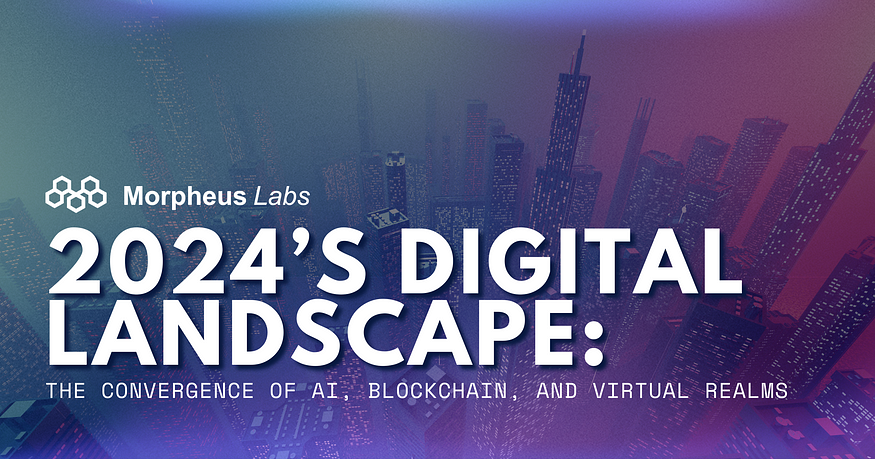News blog
labore et dolore magna eiusmod
consectetur adipiscing elit, sed do eiusmod tempor incididunt ut labore et dolore magna aliqua. Ut enim ad minim veniam, quis nostrud exercitation ullamco laboris nisi ut aliquip ex ea commodo consequat risus Ut mattis

2024’s Digital Landscape: The Convergence of AI, Blockchain, and Virtual Realms
Three strong forces dominate the rapidly changing technological landscape: artificial intelligence (AI), blockchain, and virtual worlds. As we approach the year 2024, these areas are no longer operating in isolation, but are gradually converging, heralding a unified future marked by unparalleled innovation and disruption. This confluence signals a fundamental paradigm change, as the borders between AI-driven innovations, blockchain-powered solutions, and immersive virtual environments blur, opening up new possibilities and opportunities. Let’s look deeper into three key areas that highlight the synergistic potential of AI, Blockchain, and Virtual Worlds as they work together to form the digital environment of the future.
- AI-Powered Virtual Economies
In 2024, virtual worlds will experience a tremendous metamorphosis, evolving from purely imaginative playgrounds to vibrant economies powered by AI and Blockchain. Advanced AI-powered NPCs not only improve user experiences, but they also actively participate in economic activities including commerce, contract negotiations, and service providing. Blockchain technology ensures transparency, security, and immutability in these virtual economies, allowing for frictionless transactions and asset ownership.
Axie Infinity is a good example of this integration, with gamers collecting, breeding, and battling digital creatures known as Axies in a blockchain-based virtual environment. AI algorithms decide the abilities of these Axies, resulting in a diversified ecosystem, while blockchain ensures Axies’ ownership and scarcity as NFTs. Players participate in a variety of activities within a decentralized marketplace managed by smart contracts, demonstrating the combined future of AI, blockchain, and virtual worlds.[1]
Furthermore, platforms such as Decentraland are embracing this fusion by empowering users to create, explore, and monetise virtual experiences and assets. AI algorithms personalise interactions and optimise virtual landscapes, while blockchain technology secures digital asset ownership and traceability, enabling a dynamic economy in which users may safely buy, sell, and trade virtual lands and artworks. This convergence represents a paradigm shift in how we perceive and interact with digital worlds, opening the door to new opportunities and breakthroughs beyond gaming.
- AI-Driven Content Creation and Personalisation
The fusion of AI and Virtual Worlds in 2024 is revolutionising content creation and personalisation, catering to individual preferences across gaming, entertainment, and education. NVIDIA’s Omniverse platform exemplifies this integration, utilising AI algorithms to dynamically adjust virtual scenes and assist users while ensuring the integrity of user-generated content through blockchain technology. This combination offers a glimpse into the future of immersive digital experiences. [2]
Furthermore, AI-powered virtual assistants and avatars are increasingly important in Virtual Worlds, changing and evolving over time to form deeper interactions with users. For example, in gaming settings, AI algorithms monitor user behaviour to personalise experiences by dynamically altering difficulty levels and narratives. Blockchain technology secures user achievements and assets, instilling a sense of ownership and investment in the virtual ecosystem.
The combination of AI-powered personalisation and blockchain-enabled security improves the immersive quality of Virtual Worlds, paving the path for richer and more engaging digital interactions across multiple domains.
- Blockchain-Enabled Identity and Governance
As virtual worlds proliferate, blockchain emerges as a key technology for decentralised identification and governance solutions. In 2024, self-sovereign identities based on Blockchain will allow users to control their digital personas across many virtual worlds. Estonia, a trailblazer in e-governance, has been using blockchain technology in its X-Road system for more than a decade. This technology facilitates secure and transparent data transmission among various government departments, corporations, and individuals. Estonia uses Blockchain to safeguard the integrity and security of sensitive data while also enabling seamless interactions within its digital ecosystem. [3]
Moreover, Blockchain-based identity solutions are extending beyond virtual environments into real-world applications. Governments and organisations worldwide are exploring Blockchain for identity verification, secure access to services, and transparent governance processes. Initiatives like the W3C’s Verifiable Credentials standard and ID2020 aim to create decentralised, interoperable identity systems prioritising user privacy and security. Through these projects, individuals gain greater control over their identities, fostering trust and integrity in digital interactions across various domains.
This broader adoption of Blockchain-based identity solutions underscores its potential to revolutionise digital identity and governance landscapes. From Virtual Worlds to real-world scenarios, Blockchain offers decentralised solutions that prioritise user empowerment, privacy, and security. By driving forward a unified future of innovation and connectivity across diverse digital ecosystems, Blockchain is reshaping how identities are managed and governed in the digital age.
Morpheus Labs’ Role in AI, Blockchain, and Connectivity
In the dynamic landscape of technology, three formidable forces loom large: Artificial Intelligence (AI), Blockchain, and Virtual Worlds. As we advance into the year 2024, these domains are not merely operating in isolation but are steadily converging, heralding a unified future characterised by unprecedented innovation and transformation. This convergence represents a significant paradigm shift, where the boundaries between AI-driven advancements, blockchain-powered solutions, and immersive virtual environments blur, giving rise to new possibilities and opportunities. Let’s delve deeper into three key points that underscore the synergistic potential of AI, Blockchain, and Virtual Worlds as they merge to shape the digital landscape of tomorrow.
Conclusion
The convergence of Artificial Intelligence (AI), Blockchain, and Virtual Worlds in 2024 signals a watershed moment on the path to a more integrated future of innovation and transformation. AI-powered virtual economies, such as Axie Infinity and Decentraland, are thriving, with Blockchain providing transparency and security in transactions within these digital domains. This integration transforms content production, personalization, and governance by providing decentralised options for identity management. Blockchain initiatives such as Estonia’s X-Road system, as well as global ones like the W3C’s Verifiable Credentials standard, demonstrate the technology’s potential to change digital identity landscapes.
Furthermore, Morpheus Labs’ SEED Platform, Smart Contract Studio, and Web3 Workflow Studio streamline development processes, enabling developers to capitalise on the synergies between AI, Blockchain, and Virtual Worlds, propelling a unified future of digital innovation and connectivity. This convergence highlights the revolutionary power of AI, Blockchain, and Virtual Worlds to shape the future of technology and human interaction.



















